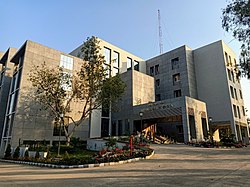Some of the major initiatives under National Health Mission (NHM) are as follows:
Janani Suraksha Yojana
Janani Suraksha Yojana (JSY) is a safe motherhood intervention scheme implemented by the Government of India. [4] [5] [6] It was launched on 12 April 2005 by the Prime Minister of India. [7] It aims to promote institutional delivery among poor pregnant women and to reduce neo-natal mortality and maternal mortality. It is operated under the Ministry of Health and Family Welfare as part of the National Rural Health Mission. The Scheme integrates cash assistance with delivery and post-delivery care, particularly in states with low institutional delivery rates.
In 2014 -15, 10,438,000 women obtained benefits under the scheme. [8] As per the World Health Organization, the proportion of institutional deliveries in India almost tripled between 2005 and 2016, from 18% to 52%. [9]
Components of the scheme
The Janani Suraksha Yojana was implemented to ensure that pregnant women who are Below the Poverty Line (BPL) access health facilities for childbirth. It provides cash benefit to eligible pregnant women if they choose to deliver in a health facility, irrespective of their age and the number of children they have.
Special dispensation is provided to states that have low institutional delivery rates. These states are Uttar Pradesh, Uttarakhand, Bihar, Jharkhand, Madhya Pradesh, Chhattisgarh, Assam, Rajasthan, Odisha, and Jammu and Kashmir, and are referred to as Low Performing States (LPS) under the Scheme. [10] Other states and Union Territories are called High Performing States (HPS) owing to their higher institutional delivery rates.
Accredited Social Health Activists (ASHA) are also incentivised under the Scheme for promoting institutional deliveries among pregnant women.
Entitlements under the scheme
The Scheme has different eligibility criteria in Low Performing States (LPS) and High Performing States (HPS). [11]
In LPS, all pregnant women delivering in government health facilities are eligible for a cash benefit. Women who choose to deliver in accredited private institutions are eligible only if they are Below the Poverty Line or belong to a Scheduled Caste or Scheduled Tribe.
In HPS, only pregnant women who are Below the Poverty Line or belong to a Scheduled Caste or Scheduled Tribe are eligible for cash benefits, irrespective of whether they choose to deliver in a government health facility or an accredited private institution.
Women who are Below the Poverty Line and choose to deliver at home are entitled to a cash assistance of ₹500 per delivery.
The cash entitlements under the Scheme are as follows [12]
All values in ₹ (INR)| Category | Rural | Urban |
|---|
| Mother's Package | ASHA's Package | Mother's Package | ASHA's Package |
| LPS | 1400 | 600 | 1000 | 400 |
| HPS | 700 | 600 | 600 | 400 |
ASHA package of ₹600 in rural areas includes ₹300 for antenatal care and ₹300 for facilitating institutional delivery. In urban areas, ₹400 include ₹200 for antenatal component and ₹200 for facilitating institutional delivery.
In 2013, the Ministry of Health and Family Welfare introduced direct payment of the entitlement to the beneficiary's bank accounts in 121 districts across the country. [8]
Impact
The number of beneficiaries under the Scheme from 2012–13 to 2014-15 were as follows
Number of beneficiaries under the Scheme from 2012–13 to 2014-15 [8] | Year | Number of beneficiaries |
|---|
| 2012-13 | 1,06,57,091 |
| 2013-14 | 1,06,48,487 |
| 2014-15 | 1,04,38,905 |
Of the beneficiaries reported in 2014–15, 87% belonged to rural areas. [8] In the same year, about 9 lakh ASHA workers also received incentives for promoting institutional deliveries among pregnant women. [8]
During 2006 - 2008, the Scheme may also have resulted in a 7% - 12% rise in the probability of childbirth or pregnancy in 10 states. [13]
The Infant Mortality rate in the country since the implementation of the scheme has been as follows
Infant Mortality Rate in India - per 1000 live births [14] | Year | Infant Mortality Rate |
|---|
| 2005 | 55.7 |
| 2006 | 53.7 |
| 2007 | 51.6 |
| 2008 | 49.5 |
| 2009 | 47.4 |
| 2010 | 45.3 |
| 2011 | 43.2 |
| 2012 | 41.1 |
| 2013 | 39.1 |
| 2014 | 37.2 |
| 2015 | 35.3 |
The maternal mortality ratio in India since the implementation of the scheme has been as follows
Maternal Mortality Ratio - National Estimate per 100,000 births [15] | Year | Maternal Mortality Ratio |
|---|
| 2006 | 250 |
| 2009 | 210 |
| 2012 | 180 |
| 2013 | 170 |
Janani Shishu Suraksha Karyakram (JSSK)
As part of recent initiatives and further moving in the direction of universal healthcare, Janani Shishu Suraksha Karyakarm (JSSK) was introduced to provide free transport, free drugs, free diagnostic, free blood, free diet to pregnant women who come for delivery in public health institutions and sick infants up to one year.

